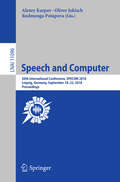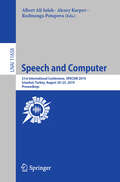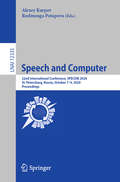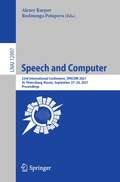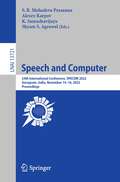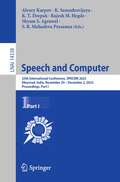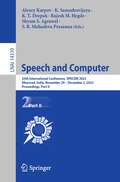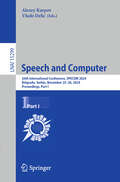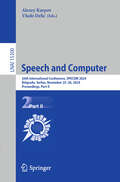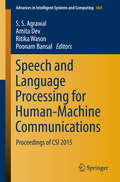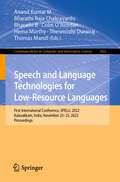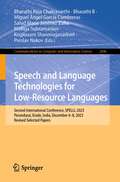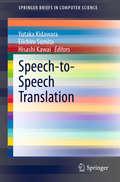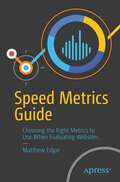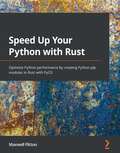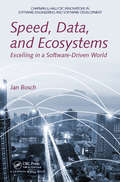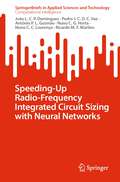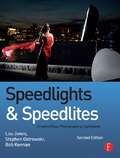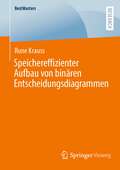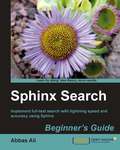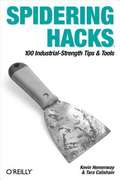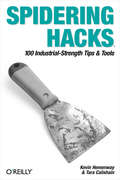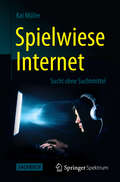- Table View
- List View
Speech and Computer: 20th International Conference, SPECOM 2018, Leipzig, Germany, September 18–22, 2018, Proceedings (Lecture Notes in Computer Science #11096)
by Rodmonga Potapova Alexey Karpov Oliver JokischThis book constitutes the proceedings of the 20th International Conference on Speech and Computer, SPECOM 2018, held in Leipzig, Germany, in September 2018.The 79 papers presented in this volume were carefully reviewed and selected from 132 submissions. The papers present current research in the area of computer speech processing, including recognition, synthesis, understanding and related domains like signal processing, language and text processing, computational paralinguistics, multi-modal speech processing or human-computer interaction.
Speech and Computer: 21st International Conference, SPECOM 2019, Istanbul, Turkey, August 20–25, 2019, Proceedings (Lecture Notes in Computer Science #11658)
by Albert Ali Salah Rodmonga Potapova Alexey KarpovThis book constitutes the proceedings of the 21st International Conference on Speech and Computer, SPECOM 2019, held in Istanbul, Turkey, in August 2019.The 57 papers presented were carefully reviewed and selected from 86 submissions. The papers present current research in the area of computer speech processing including audio signal processing, automatic speech recognition, speaker recognition, computational paralinguistics, speech synthesis, sign language and multimodal processing, and speech and language resources.
Speech and Computer: 22nd International Conference, SPECOM 2020, St. Petersburg, Russia, October 7–9, 2020, Proceedings (Lecture Notes in Computer Science #12335)
by Rodmonga Potapova Alexey KarpovThis book constitutes the proceedings of the 22nd International Conference on Speech and Computer, SPECOM 2020, held in St. Petersburg, Russia, in October 2020. The 65 papers presented were carefully reviewed and selected from 160 submissions. The papers present current research in the area of computer speech processing including speech science, speech technology, natural language processing, human-computer interaction, language identification, multimedia processing, human-machine interaction, deep learning for audio processing, computational paralinguistics, affective computing, speech and language resources, speech translation systems, text mining and sentiment analysis, voice assistants, etc.Due to the Corona pandemic SPECOM 2020 was held as a virtual event.
Speech and Computer: 23rd International Conference, SPECOM 2021, St. Petersburg, Russia, September 27–30, 2021, Proceedings (Lecture Notes in Computer Science #12997)
by Rodmonga Potapova Alexey KarpovThis book constitutes the proceedings of the 23rd International Conference on Speech and Computer, SPECOM 2021, held in St. Petersburg, Russia, in September 2021.* The 74 papers presented were carefully reviewed and selected from 163 submissions. The papers present current research in the area of computer speech processing including audio signal processing, automatic speech recognition, speaker recognition, computational paralinguistics, speech synthesis, sign language and multimodal processing, and speech and language resources.*Due to the COVID-19 pandemic, SPECOM 2021 was held as a hybrid event.
Speech and Computer: 24th International Conference, SPECOM 2022, Gurugram, India, November 14–16, 2022, Proceedings (Lecture Notes in Computer Science #13721)
by S. R. Mahadeva Prasanna Alexey Karpov K. Samudravijaya Shyam S. AgrawalThis book constitutes the proceedings of the 24th International Conference on Speech and Computer, SPECOM 2022, held as a hybrid event in Gurugram, India, in November 2022.The 51 full and 9 short papers presented in this volume were carefully reviewed and selected from 99 submissions. The papers present current research in the area of computer speech processing including audio signal processing, automatic speech recognition, speaker recognition, computational paralinguistics, speech synthesis, sign language and multimodal processing, and speech and language resources.
Speech and Computer: 25th International Conference, SPECOM 2023, Dharwad, India, November 29 – December 2, 2023, Proceedings, Part I (Lecture Notes in Computer Science #14338)
by S. R. Mahadeva Prasanna Alexey Karpov Rajesh M. Hegde K. Samudravijaya Shyam S. Agrawal K. T. DeepakThe two-volume proceedings set LNAI 14338 and 14339 constitutes the refereed proceedings of the 25th International Conference on Speech and Computer, SPECOM 2023, held in Dharwad, India, during November 29–December 2, 2023.The 94 papers included in these proceedings were carefully reviewed and selected from 174 submissions. They focus on all aspects of speech science and technology: automatic speech recognition; computational paralinguistics; digital signal processing; speech prosody; natural language processing; child speech processing; speech processing for medicine; industrial speech and language technology; speech technology for under-resourced languages; speech analysis and synthesis; speaker and language identification, verification and diarization.
Speech and Computer: 25th International Conference, SPECOM 2023, Dharwad, India, November 29 – December 2, 2023, Proceedings, Part II (Lecture Notes in Computer Science #14339)
by S. R. Mahadeva Prasanna Alexey Karpov Rajesh M. Hegde K. Samudravijaya Shyam S. Agrawal K. T. DeepakThe two-volume proceedings set LNAI 14338 and 14339 constitutes the refereed proceedings of the 25th International Conference on Speech and Computer, SPECOM 2023, held in Dharwad, India, during November 29–December 2, 2023.The 94 papers included in these proceedings were carefully reviewed and selected from 174 submissions. They focus on all aspects of speech science and technology: automatic speech recognition; computational paralinguistics; digital signal processing; speech prosody; natural language processing; child speech processing; speech processing for medicine; industrial speech and language technology; speech technology for under-resourced languages; speech analysis and synthesis; speaker and language identification, verification and diarization.
Speech and Computer: 26th International Conference, SPECOM 2024, Belgrade, Serbia, November 25–28, 2024, Proceedings, Part I (Lecture Notes in Computer Science #15299)
by Alexey Karpov Vlado DelićThe two-volume set LNAI 15299 and 15300 constitutes the refereed proceedings of the 26th International Conference on Speech and Computer, SPECOM 2024, held in Belgrade, Serbia, during November 25–28, 2024. The 53 full papers included in these proceedings were carefully reviewed and selected from 90 submissions. The book also contains two invited talks in full paper length. The papers are organized in the following topical sections: Volume I: Invited papers; automatic speech recognition; speech and language resources; speech synthesis and perception; and speech processing for medicine. Volume II: Computational paralinguistics; affective computing; speaker recognition; digital speech processing; natural language processing.
Speech and Computer: 26th International Conference, SPECOM 2024, Belgrade, Serbia, November 25–28, 2024, Proceedings, Part II (Lecture Notes in Computer Science #15300)
by Alexey Karpov Vlado DelićThe two-volume set LNAI 15299 and 15300 constitutes the refereed proceedings of the 26th International Conference on Speech and Computer, SPECOM 2024, held in Belgrade, Serbia, during November 25–28, 2024. The 53 full papers included in these proceedings were carefully reviewed and selected from 90 submissions. The book also contains two invited talks in full paper length. The papers are organized in the following topical sections: Volume I: Invited papers; automatic speech recognition; speech and language resources; speech synthesis and perception; and speech processing for medicine. Volume II: Computational paralinguistics; affective computing; speaker recognition; digital speech processing; natural language processing.
Speech and Language Processing for Human-Machine Communications
by S. S. Agrawal Amita Devi Ritika Wason Poonam BansalThis volume comprises the select proceedings of the annual convention of the Computer Society of India. Divided into 10 topical volumes, the proceedings present papers on state-of-the-art research, surveys, and succinct reviews. The volumes cover diverse topics ranging from communications networks to big data analytics, and from system architecture to cyber security. This volume focuses on Speech and Language Processing for Human-Machine Communications. The contents of this book will be useful to researchers and students alike.
Speech and Language Technologies for Low-Resource Languages: First International Conference, SPELLL 2022, Kalavakkam, India, November 23–25, 2022, Proceedings (Communications in Computer and Information Science #1802)
by Thomas Mandl Anand Kumar M Bharathi Raja Chakravarthi Bharathi B Colm O’Riordan Hema Murthy Thenmozhi DurairajThis book constitutes refereed proceedings from the First International Conference on Speech and Language Technologies for Low-resource Languages, SPELLL 2022, held in Kalavakkam, India, in November 2022. The 25 presented papers were thoroughly reviewed and selected from 70 submissions. The papers are organised in the following topical sections: language resources; language technologies; speech technologies; multimodal data analysis; fake news detection in low-resource languages (regional-fake); low resource cross-domain, cross-lingualand cross-modal offensie content analysis (LC4).
Speech and Language Technologies for Low-Resource Languages: Second International Conference, SPELLL 2023, Perundurai, Erode, India, December 6–8, 2023, Revised Selected Papers (Communications in Computer and Information Science #2046)
by Preslav Nakov Bharathi Raja Chakravarthi Bharathi B Miguel Ángel García Cumbreras Salud María Jiménez Zafra Malliga Subramanian Kogilavani ShanmugavadivelThis book constitutes the refereed conference proceedings of the second International Conference on Speech and Language Technologies for Low-Resource Languages, SPELLL 2023, held in Perundurai, Erode, India, during December 6–8, 2023. The 27 full papers and 6 short papers presented in this book were carefully reviewed and selected from 94 submissions. The papers are divided into the following topical sections: language resources; language technologies; speech technologies; and workshops - regional fake, MMLOW, LC4.
Speech-to-Speech Translation (SpringerBriefs in Computer Science)
by Yutaka Kidawara Eiichiro Sumita Hisashi KawaiThis book provides the readers with retrospective and prospective views with detailed explanations of component technologies, speech recognition, language translation and speech synthesis.Speech-to-speech translation system (S2S) enables to break language barriers, i.e., communicate each other between any pair of person on the glove, which is one of extreme dreams of humankind.People, society, and economy connected by S2S will demonstrate explosive growth without exception.In 1986, Japan initiated basic research of S2S, then the idea spread world-wide and were explored deeply by researchers during three decades.Now, we see S2S application on smartphone/tablet around the world.Computational resources such as processors, memories, wireless communication accelerate this computation-intensive systems and accumulation of digital data of speech and language encourage recent approaches based on machine learning.Through field experiments after long research in laboratories, S2S systems are being well-developed and now ready to utilized in daily life.Unique chapter of this book is end-2-end evaluation by comparing system’s performance and human competence. The effectiveness of the system would be understood by the score of this evaluation.The book will end with one of the next focus of S2S will be technology of simultaneous interpretation for lecture, broadcast news and so on.
Speed Metrics Guide: Choosing the Right Metrics to Use When Evaluating Websites
by Matthew EdgarFaster websites offer a better user experience and typically have higher conversion rates. It can be challenging to know where to invest to meaningfully improve a website's speed. Investing correctly to improve speed starts with understanding how to correctly measure speed and knowing how to use those measurements to identify the biggest opportunities. Speed Metrics Guide helps marketers, SEOs, business leaders, designers, and everybody else involved in website performance select the right metrics to use to optimize their website's speed. Each chapter examines a specific metric, discusses what it measures, why the metric matters and what tactics will help improve that metric. What You'll LearnThe best metrics and tools to help you measure website speed, including Google's Core Web VitalsHow and when to best use each metricWhere each metric fits within the website loading processHow to use each metric to find different ways of improving website speed Who This book Is ForNon-technical audience, including marketers, SEOs, designers, and UX professionals.
Speed Up Your Python with Rust: Optimize Python performance by creating Python pip modules in Rust with PyO3
by Maxwell FlittonDiscover how to inject your code with highly performant Rust features to develop fast and memory-safe applicationsKey FeaturesLearn to implement Rust in a Python system without altering the entire systemWrite safe and efficient Rust code as a Python developer by understanding the essential features of RustBuild Python extensions in Rust by using Python NumPy modules in your Rust codeBook DescriptionPython has made software development easier, but it falls short in several areas including memory management that lead to poor performance and security. Rust, on the other hand, provides memory safety without using a garbage collector, which means that with its low memory footprint, you can build high-performant and secure apps relatively easily. However, rewriting everything in Rust can be expensive and risky as there might not be package support in Rust for the problem being solved. This is where Python bindings and pip come in.This book will help you, as a Python developer, to start using Rust in your Python projects without having to manage a separate Rust server or application. Seeing as you'll already understand concepts like functions and loops, this book covers the quirks of Rust such as memory management to code Rust in a productive and structured manner. You'll explore the PyO3 crate to fuse Rust code with Python, learn how to package your fused Rust code in a pip package, and then deploy a Python Flask application in Docker that uses a private Rust pip module. Finally, you'll get to grips with advanced Rust binding topics such as inspecting Python objects and modules in Rust.By the end of this Rust book, you'll be able to develop safe and high-performant applications with better concurrency support.What you will learnExplore the quirks of the Rust programming language that a Python developer needs to understand to code in RustUnderstand the trade-offs for multiprocessing and thread safety to write concurrent codeBuild and manage a software project with cargo and cratesFuse Rust code with Python so that Python can import and run Rust codeDeploy a Python Flask application in Docker that utilizes a private Rust pip moduleInspect and create your own Python objects in RustWho this book is forThis book is for Python developers who want to speed up their Python code with Rust and implement Rust in a Python system without altering the entire system. You'll be able to learn about all topics relating to Rust programming. Basic knowledge of Python is required to get the most out of this book.
Speed, Data, and Ecosystems: Excelling in a Software-Driven World (Chapman & Hall/CRC Innovations in Software Engineering and Software Development Series)
by Jan BoschAs software R&D investment increases, the benefits from short feedback cycles using technologies such as continuous deployment, experimentation-based development, and multidisciplinary teams require a fundamentally different strategy and process. This book will cover the three overall challenges that companies are grappling with: speed, data and ecosystems. Speed deals with shortening the cycle time in R&D. Data deals with increasing the use of and benefit from the massive amounts of data that companies collect. Ecosystems address the transition of companies from being internally focused to being ecosystem oriented by analyzing what the company is uniquely good at and where it adds value.
Speeding-Up Radio-Frequency Integrated Circuit Sizing with Neural Networks (SpringerBriefs in Applied Sciences and Technology)
by Nuno C. Lourenço Ricardo M. Martins Nuno C. Horta João L. Domingues Pedro J. Vaz António P. GusmãoIn this book, innovative research using artificial neural networks (ANNs) is conducted to automate the sizing task of RF IC design, which is used in two different steps of the automatic design process. The advances in telecommunications, such as the 5th generation broadband or 5G for short, open doors to advances in areas such as health care, education, resource management, transportation, agriculture and many other areas. Consequently, there is high pressure in today’s market for significant communication rates, extensive bandwidths and ultralow-power consumption. This is where radiofrequency (RF) integrated circuits (ICs) come in hand, playing a crucial role. This demand stresses out the problem which resides in the remarkable difficulty of RF IC design in deep nanometric integration technologies due to their high complexity and stringent performances. Given the economic pressure for high quality yet cheap electronics and challenging time-to-market constraints, there is an urgent need for electronic design automation (EDA) tools to increase the RF designers’ productivity and improve the quality of resulting ICs. In the last years, the automatic sizing of RF IC blocks in deep nanometer technologies has moved toward process, voltage and temperature (PVT)-inclusive optimizations to ensure their robustness. Each sizing solution is exhaustively simulated in a set of PVT corners, thus pushing modern workstations’ capabilities to their limits. Standard ANNs applications usually exploit the model’s capability of describing a complex, harder to describe, relation between input and target data. For that purpose, ANNs are a mechanism to bypass the process of describing the complex underlying relations between data by feeding it a significant number of previously acquired input/output data pairs that the model attempts to copy. Here, and firstly, the ANNs disrupt from the most recent trials of replacing the simulator in the simulation-based sizing with a machine/deep learning model, by proposing two different ANNs, the first classifies the convergence of the circuit for nominal and PVT corners, and the second predicts the oscillating frequencies for each case. The convergence classifier (CCANN) and frequency guess predictor (FGPANN) are seamlessly integrated into the simulation-based sizing loop, accelerating the overall optimization process. Secondly, a PVT regressor that inputs the circuit’s sizing and the nominal performances to estimate the PVT corner performances via multiple parallel artificial neural networks is proposed. Two control phases prevent the optimization process from being misled by inaccurate performance estimates. As such, this book details the optimal description of the input/output data relation that should be fulfilled. The developed description is mainly reflected in two of the system’s characteristics, the shape of the input data and its incorporation in the sizing optimization loop. An optimal description of these components should be such that the model should produce output data that fulfills the desired relation for the given training data once fully trained. Additionally, the model should be capable of efficiently generalizing the acquired knowledge in newer examples, i.e., never-seen input circuit topologies.
Speedlights & Speedlites: Creative Flash Photography at the Speed of Light
by Lou JonesCanon Speedlites and Nikon Speedlights are small, off-camera flashguns that can provide big results - if you know how to use them properly. Acclaimed Boston photographers Lou Jones, Bob Keenan and Steve Ostrowski guide you through the technical and creative aspects of how to get the most out of these powerful tools in this indispensable guide, packed full of inspirational images and comprehensive diagrams of the lighting set ups used to capture them. They are significantly more advanced, lighter and considerably cheaper than a standard flashgun, and have many advantages. They are small (and cheap) enough that a number can be carried in your kit, and they can be used in combination, triggered wirelessly. They use through-the-lens (TTL) metering, which allows you to use the in-camera LCD and histograms to calculate the required power/direction, rather than havng to use a light meter or trial and error. They use proprietary, dedicated technology (from Canon and Nikon) that means there are no compatability issues. Getting the most out of them, however, remains a mystery - most photographers still just use their speedlights in the same way as a standard flash gun. This is where this book comes in.
Speichereffizienter Aufbau von binären Entscheidungsdiagrammen (BestMasters)
by Rune KraussAufgrund der steigenden Komplexität von Hardwaresystemen besteht die Notwendigkeit, effizientere Datenstrukturen und darauf operierende Algorithmen zu entwickeln, um weiterhin das korrekte Verhalten solcher Systeme zu garantieren. Ein binäres Entscheidungsdiagramm ist eine geeignete Datenstruktur, da sie eine kompakte Repräsentation boolescher Funktionen und effiziente Algorithmen zur Manipulation dieser bietet. Allerdings haben Entscheidungsdiagramme auch Herausforderungen zu bewältigen: Die Praktikabilität hängt von deren Minimierung ab und es besteht ein großer Speicherbedarf für einige komplexe Funktionen. Dieses Buch präsentiert Ansätze, in denen boolesche Normalformen unter Ordnungsdefinitionen und Gesetzen der booleschen Algebra mit dem Ziel angeordnet werden, die Anzahl an Zwischenberechnungen zum Aufbau binärer Entscheidungsdiagramme zu verringern und den Speicher- sowie Zeitbedarf zu reduzieren. Die Methoden werden in ein Softwarepaket integriert, um die Performanz anhand von Benchmark-Instanzen zu untersuchen und mit dem Stand der Forschung zu vergleichen.
Spelunky (Boss Fight Books)
by Derek YuWhen Derek Yu released Spelunky for free in 2008, his roguelike-inspired platformer took the indie game community by storm with its combination of classic platform mechanics, extreme difficulty, and random level generation. Four years later, Spelunky's HD remake went on to become PC Gamer's Game of the Year and earn perfect scores from Polygon and Eurogamer. But how is a perfect game made? Spelunky is Boss Fight's first autobiographical book: the story of a game's creation as told by its creator. Using his own game as a vehicle, Derek Yu discusses such wide-ranging topics as randomization, challenge, indifferent game worlds, player feedback, development team dynamics, and what's required to actually finish a game. Grab some ropes, a mattock, and your favorite pug—this book is going to dig deep.
Sphinx Search Beginner's Guide
by Abbas AliThis book is a step-by-step guide for an absolute beginner. It covers everything, from installing to configuring, to get you started quickly. It has numerous code examples that the reader can try on their own and learn while doing so. It has two full-fledged applications as examples that readers can follow. This book is specifically focused on the Search feature of web applications.This book is for developers who are new to Sphinx Search. All code examples use PHP but the logic is same for any other web scripting languages as well.
Spider Man Unlimited Guia Não-Oficial
by João Wolf Joshua Abbott*Guia Não-Oficial* Dicas Avançadas e Guia de Estratégias. Este é o mais completo e o único guia detalhado que você encontrará on-line. Disponível para download instantâneo no seu celular, leitor de eBook, ou em forma impressa. Veja o que você irá receber ao adquirir este detalhado e avançado guia profissional de games. - Dicas e Estratégias Profissionais. - Formas de Trapacear. - Segredos, Dicas, Formas de Trapacear, Itens Desbloqueáveis, e Truques utilizados por Jogadores Profissionais! - Como Coletar Toneladas de Moeadas. - E MUITO MAIS! Aviso Legal: Este produto não é associado, afiliado, aprovado, certificado ou patrocinado pelo detentor original do Copyright. Todas as Marcas e Marcas Registradas que aparecem neste eBook são de propriedade dos seus respectivos donos.
Spidering Hacks
by Kevin Hemenway Tara CalishainWritten for developers, researchers, technical assistants, librarians, and power users, Spidering Hacks provides expert tips on spidering and scraping methodologies. You'll begin with a crash course in spidering concepts, tools (Perl, LWP, out-of-the-box utilities), and ethics (how to know when you've gone too far: what's acceptable and unacceptable). Next, you'll collect media files and data from databases. Then you'll learn how to interpret and understand the data, repurpose it for use in other applications, and even build authorized interfaces to integrate the data into your own content.
Spidering Hacks: 100 Industrial-Strength Tips & Tools
by Tara Calishain Morbus IffThe Internet, with its profusion of information, has made us hungry for ever more, ever better data. Out of necessity, many of us have become pretty adept with search engine queries, but there are times when even the most powerful search engines aren't enough. If you've ever wanted your data in a different form than it's presented, or wanted to collect data from several sites and see it side-by-side without the constraints of a browser, then Spidering Hacks is for you.Spidering Hacks takes you to the next level in Internet data retrieval--beyond search engines--by showing you how to create spiders and bots to retrieve information from your favorite sites and data sources. You'll no longer feel constrained by the way host sites think you want to see their data presented--you'll learn how to scrape and repurpose raw data so you can view in a way that's meaningful to you.Written for developers, researchers, technical assistants, librarians, and power users, Spidering Hacks provides expert tips on spidering and scraping methodologies. You'll begin with a crash course in spidering concepts, tools (Perl, LWP, out-of-the-box utilities), and ethics (how to know when you've gone too far: what's acceptable and unacceptable). Next, you'll collect media files and data from databases. Then you'll learn how to interpret and understand the data, repurpose it for use in other applications, and even build authorized interfaces to integrate the data into your own content. By the time you finish Spidering Hacks, you'll be able to:Aggregate and associate data from disparate locations, then store and manipulate the data as you likeGain a competitive edge in business by knowing when competitors' products are on sale, and comparing sales ranks and product placement on e-commerce sitesIntegrate third-party data into your own applications or web sitesMake your own site easier to scrape and more usable to othersKeep up-to-date with your favorite comics strips, news stories, stock tips, and more without visiting the site every dayLike the other books in O'Reilly's popular Hacks series, Spidering Hacks brings you 100 industrial-strength tips and tools from the experts to help you master this technology. If you're interested in data retrieval of any type, this book provides a wealth of data for finding a wealth of data.
Spielwiese Internet: Sucht ohne Suchtmittel
by Kai MüllerInternetsucht ist eine moderne Form einer psychischen Problematik, die offensichtlich immer mehr Menschen etwas angeht, entweder direkt oder indirekt. Wie eine verschwommene Schimäre taucht dieses Schlagwort "Internetsucht" in den Medien auf. Zahlen von Betroffenen, Symptome und Auswirkungen dieses neuen Phänomens werden von unterschiedlichen Experten in unterschiedlicher Weise diskutiert und dennoch bleibt der Nicht-Fachmann nur allzu oft mit mehr Fragen als Antworten zurück. Dieses Buch soll dem Leser einen möglichst umfassenden Einblick vermitteln. Es vermittelt Antworten auf zentrale Fragen, wie z.B.: Was verbirgt sich hinter dem Begriff der Internetsucht? Wann ist ein Verhalten bereits Ausdruck einer Sucht? Welche Menschen sind als besonders gefährdet anzusehen? Welche Maßnahmen können ergriffen werden, um einer Internetsucht zu begegnen? Der aktuelle psychologische Kenntnisstand wurde hierzu nachvollziehbar aufbereitet und in einen engen praxisnahen Bezug gesetzt. Zielgruppen für dieses Werk sind alle, die sich über das Thema Spiel- und Internetsucht informieren möchten sowie alle, die selbst oder in ihrem familiären Umfeld oder Bekanntenkreis Menschen kennen, die davon betroffen sind. Nebenzielgruppe sind alle diejenigen, die im beruflichen Umfeld mit Betroffenen zu tun haben. Der Autor ist Diplompsychologe und arbeitet in der deutschlandweit einzigartigen Ambulanz für Spielsucht. Innerhalb seines beruflichen Umfeldes befasst er sich intensiv mit dem Thema der substanzungebundenen Abhängigkeitserkrankungen (Verhaltenssüchte), hier insbesondere mit der Internet- und Computerspielsucht sowie der Glücksspielsucht.
